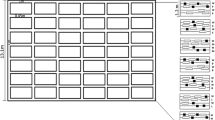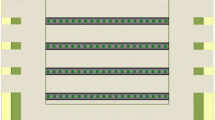Abstract
A field trial was conducted to investigate the use of peas (Pisum sativum cv. Valverde), wheat (Triticum aestivum cv. Capo) and oilseed radish (Raphanus sativus var. oleiformis cv. Adagio) as trap crops to control wireworm in potato fields. We investigated the efficacy of trap crops and distance of attraction by counting larvae in both potato and trap crop rows. Wireworms of the genera Agriotes, Adrastus and Hemicrepidius were observed. In the plots planted with peas as a trap crop, significantly more wireworms were observed than in the other treatments, which was clearly due to the influence of the trap crop pea. The potato rows 0.75 m away from the peas showed 2.4 times more larvae than the potato rows 1.5 m away. This may be due to a decrease of the peas’ attractiveness over time (Miles and Petherbridge 1927), with wireworms that were initially attracted to the peas moving back to the nearby potatoes. In the plots planted with wheat, oilseed radish and the control (bare soil instead of a trap crop), there was no significant difference in numbers of larvae between the potato rows. In the control plots, significantly more larvae were found in the potato rows than in the bare soil. We assessed the damage to potato tubers by weighing them and counting the wireworm holes. Our results indicate that peas are more attractive to wireworms than potatoes and might be an effective trap crop if the right timing and spacing relative to the potatoes is found.

Similar content being viewed by others
References
Crombie AC, Darrah JH (1947) The chemoreceptors of the wireworm (Agriotes spp.) and the relation of activity to chemical constitution. J Exp Biol 24:95–109
Doane JF, Lee YW, Klingler J, Westcott ND (1975) The orientation response of Ctenicera destructor and other wireworms (Coleoptera: Elateridae) to germinating grain and to carbon dioxide. Can Entomol 107:1233–1252
Glauninger J, Meixner C, Landl M (2004) Zunehmende Drahtwurmprobleme bei Feldkulturen—Gefahr für Saat, Knollen und Jungpflanzen. Der Pflanzenarzt 57:4–7
Griffiths DC (1974) Susceptibility of plants to attack by wireworms (Agriots spp.). Ann Appl Biol 78:7–13
Hokkanen HMT (1991) Trap cropping in pest management. Annu Rev Entomol 36:119–138
Jonasson T, Olsson K (1994) The influence of glycoalkaloids, chlorogenic acid and sugars on the susceptibility of potato tubers to wireworm. Potato Res 37:205–216
Kabanov VA (1975) Über Vorkommen und Entwicklung von Agriotes lineatus (Coleoptera, Elateridae) im europäischen Teil der UdSSR. Pedobiol 15:98–105
Klausnitzer B (1994) Familie Elateridae. In: Klausnitzer B (ed) Die Larven der Käfer Mitteleuropas 2. Band. Myxophaga/Polyphaga. Gustav Fischer Verlag, Jena, pp 118–189
Klingler J (1957) Über die Bedeutung des Kohlendioxyds für die Orientierung der Larven von Otiorrhynchus sulcatus F., Melolontha und Agriotes (Col.) im Boden. Vorläufige Mitteilung. Mitt Schweizer Entomol Ges XXX:317–322
Klingler J, Doane JF (1974) Verminderung des Drahtwurmschadens an Erdbeersetzlingen durch Fangpflanzen. Schweiz Z Obst- u. Weinbau 110:739–742
Kolbe H (1996) Einflussfaktoren auf Ertrag und Inhaltsstoffe der Kartoffel. II Zucker. Sächsisches Landesamt für Umwelt, Landwirtschaft und Geologie, Leipzig. http://www.landwirtschaft.sachsen.de/landwirtschaft/download/KB2.pdf
Lacroix DS (1935) Tobacco insects in 1933—prevalence of various species. Bull Conn Agric Exp Stn 359:377–380
Langenbuch R (1932) Beiträge zur Kenntnis der Biologie von Agriotes lineatus L. und Agriotes obscurus L. Z Angew Entomol 19:278–300
McCaffrey JP, Williams L III, Borek V, Brown PD, Morra MJ (1995) Toxicity of ionic thiocyanate-amended soil to the wireworm Limonius californicus (Coleoptera: Elateridae). J Econ Entomol 88:793–797
Miles HW, Petherbridge RFR (1927) Investigations on the control of wireworms. Ann Appl Biol 14:359–387
Munson G, Keaster AJ, Grundler JA (1983) Control of wireworms and other corn soil insects. Agric Guide 4154 Extension Division. University of Missouri, Columbia
Parker WE (1994) Evaluation of the use of food baits for detecting wireworms (Agriotes spp., Coleoptera: Elateridae) in fields intended for arable crop production. Crop Prot 13:271–276
Parker WE, Howard JJ (2001) The biology and management of wireworms (Agriotes spp.) on potato with particular reference to the UK. Agric Forest Entomol 3:85–98
Rasch D, Verdooren LR, Gowers JI (2007) Planung und Auswertung von Versuchen und Erhebungen. Oldenbourg Wissenschaftsverlag, München, Wien
Roebuck A (1924) Destruction of wireworms. J Ministry Agric Fish 30:1047–1051
Russel EJ (1936) Boden und Pflanze. Verlag von Theodor Steinkopff, Dresden und Leipzig
Shelton AM, Badenes-Perez FR (2006) Concepts and applications of trap cropping in pest management. Annu Rev Entomol 51:285–308
Staudacher K, Pitterl P, Furlan L, Cate PC, Traugott M (2010) PCR-based species identification of Agriotes larvae. Bull Entomol Res. doi:10.1017/S0007485310000337
Subklew W (1935) Agriotes lineatus L. und Agriotes obscurus L. (Ein Beitrag zur Morphologie und Biologie). Z Angew Entomol 21:96–122
Vernon RS, Kabaluk T, Behringer A (2000) Movement of Agriotes obscurus (Coleoptera: Elateridae) in strawberry (Rosaceae) plantings with wheat (Gramineae) as a trap crop. Can Entomol 132:231–241
Wilke S (1927) Insekten, Drahtwürmer. Mitt Biol Reichsanst 30:31–34
Acknowledgments
The authors would like to thank Dieter Rasch and Karl Moder, Institute of Applied Statistics and Computing; University of Natural Resources and Applied Life Sciences, Vienna and Rod Blackshaw, School of Biological Science, University of Plymouth, UK for their help and advice on statistical and spatial analyses. We are grateful for the co-operation and assistance of the staff of the Experimental Farm Grossenzersdorf during the course of this experiment. This work is a part of the project: “New approaches to regulating wireworms, with a special emphasis on organic farming” under Project no. 1448 funded by the Federal Ministry of Agriculture, Forestry, Environment and Water Management, Austria.
Author information
Authors and Affiliations
Corresponding author
Additional information
Communicated by A. Juen.
Rights and permissions
About this article
Cite this article
Landl, M., Glauninger, J. Preliminary investigations into the use of trap crops to control Agriotes spp. (Coleoptera: Elateridae) in potato crops. J Pest Sci 86, 85–90 (2013). https://doi.org/10.1007/s10340-011-0348-3
Received:
Accepted:
Published:
Issue Date:
DOI: https://doi.org/10.1007/s10340-011-0348-3




